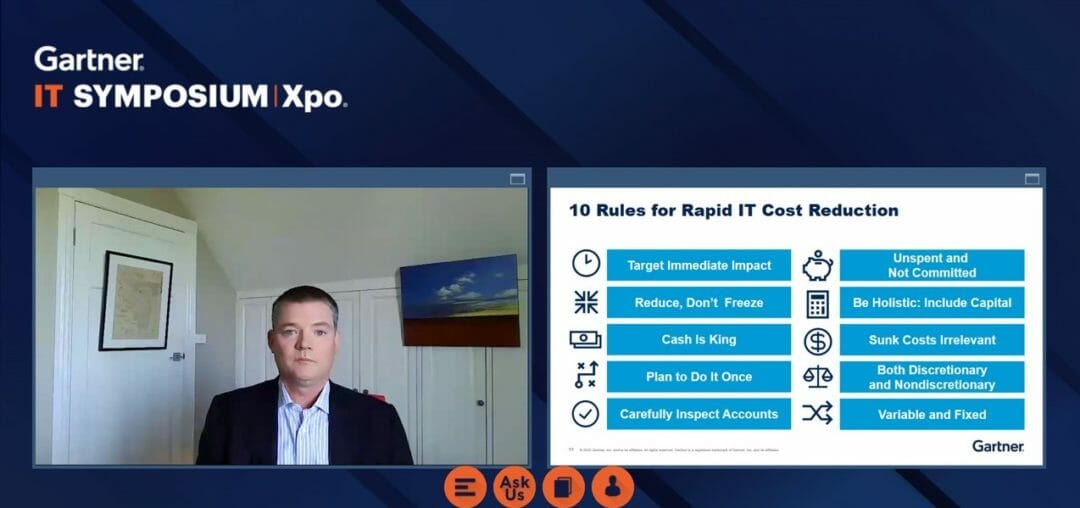As the Covid-19 pandemic continues to disrupt the global economy, CIOs are being forced to make immediate savings to IT costs.
IT spending is expected to contract across all categories and regions in 2020 and while businesses in most industries have begun to reopen, pandemic mitigation measures such as lockdowns, social distancing, travel restrictions and border shutdowns have created financial burdens, with the transportation, manufacturing and natural resources industries the most severely impacted.
Although a rebound is predicted in 2021, Chris Ganly, senior research director at Gartner, said during his talk at this week’s IT Symposium/Xpo EMEA that Covid-19 has fundamentally transformed the way people are spending their money, and organisations must respond by reducing IT costs.

Gartner advocates a strategic cost optimisation approach, which is a continuous discipline to managing spending while maximising business value, rather than simply cutting costs.
“You need to do what it takes to stay on track and cut your way to survival,” said Ganly.
“Difficult times call for difficult actions. But even in organisations fighting to survive, CIOs need to approach cost cutting in the least damaging way to the medium-and long-term health of the business.”
Gartner advises CIOs to follow 10 rules when faced with the need to cut IT costs quickly.
1. Target immediate impact
It’s recommended that organisations compress their outlook from costs incurred over a multiple year span, to in-year impacts, and expenses should be paid on a ‘pay as you go’ basis, as opposed to annually.
Companies should look to target costs that can be impacted quickly. These include ‘as-a-service’ options, communications and contract labour expenditure.
2. Reduce, don’t freeze
“Don’t just squeeze the balloon,” said Ganly. Companies should look at total spend, and not simply move expenditure away from IT.
Additionally, any possible cancellations and terminations should be considered temporarily, with a view to reintroduce the service further down the line, and fees can be renegotiated, where possible.
3. Cash is king
It’s better under the current circumstances to divert attention from account treatments and anything else that doesn’t make an immediate impact on the profit and loss statement.
This means not focusing on already owned or paid for assets, and instead focusing on ongoing costs.
With 60-65% of expenditure being externally spent on vendors and suppliers, this is a recommended starting point.
How can CIOs avoid vendor lock-in and stop repeating past mistakes?
4. Plan to do it once
Any cuts to spending should be carefully considered, and planned so it only needs to be done once.
Organisations should avoid falling into a vicious cycle of uncertainty and lost productivity, and when it comes to expenditure for staff, this needs to be approached with empathy.
5. Examine the entire cost base
Accounts need to be carefully assessed, by working closely with IT and finance teams to determine the right approach to spending.
Cost “views” involving benchmarking of all used categories should be utilised in order to identify specific cost reductions in Opex and Capex costs.
6. Target unspent and uncommitted expenses
All unspent and uncommitted expenses should be identified, with help from the vendor management team, and renegotiated or stopped where possible.
These can include spend on communications, contract labour, projects and upgrades.
7. Be holistic and include capital
While 25% of IT budgets tends to be on CapEx, with the rest being on OpEx, it’s still important to include this aspect in the outlook.
Spending on a CapEx basis can provide reduction opportunities, specifically before purchased are commencd, as well as around projects.
8. Sunk costs are irrelevant
There is no benefit in looking at past spending, so it’s best to focus on the future, and prior investments do not have to be continued if it doesn’t suit the financial situation.
When considering this, the cost benefit of stopping an investment should be balanced with value going forward.
Will cloud optimisation control spiralling IT budgets in the post COVID-19 era?
9. Address both discretionary and nondiscretionary costs
While discretionary costs may prove to be easier, both of these sides of expenditure must be addressed in the cost base.
When it comes to IT cost reduction, organisations should be aware that not all projects can be stopped, but consider targeting nondiscretionary usage, service levels, and even consumption levels, where possible.
10. Tackle variable and fixed costs
Finally, Ganly covered the need to address the possibility of reducing both variable and fixed costs, and apply the appropriate approach on a case-by-case basis.
Fixed expenditure includes office rent, applications and payroll, while variable costs can consist of communications and contractors.







